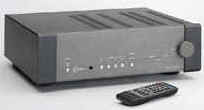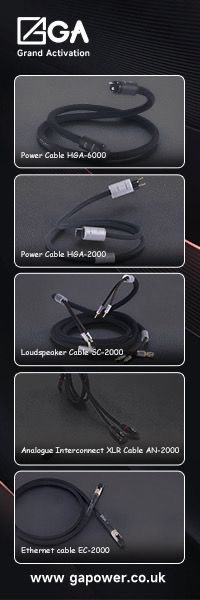Krell KAV-500i Integrated Amplifier
| Krell KAV-500i Integrated Amplifier |
| Frank Alles |
| 1 November 1999 |
 Specifications
Specifications
Frequency Response: 20 Hz to 20 kHz +0 dB, -0.17 dB
Signal to Noise Ratio, “A” Rated: 102 dB
Total Harmonic Distortion: <0.06% @ 1 kHz, <0.25% @ 20 kHz
Gain: 36.4 dB
Input Sensitivity: 0.654 Vrms
Input Impedance: 57 k ohms
Output Impedance: 0.044 ohms
Power Consumption: 230 W @ idle, 1900 W max.
Dimensions (inches): 19W × 6.3H × 15.3D
Weight: Shipping: 49 lb., Net: 57 lb.
Price: $5000. USD.
Krell Industries Inc.
45 Connair Road
Orange, CT 06477-3650 USA
Tel: 203.799.9954, Fax: 203.799.9796
E-mail: krell@krellonline.com
Web site: www.krellonline.com
“So I guess the question is: if an integrated amplifier or a single-box CD player can give you 90% of the performance of separates, cost less, take up way less space and be easier to operate, is it worth losing a few percentage points in ultimate performance?…… HELL YES!”
Over the better part of the last decade, there has been a trend toward simplification and convenience features in the high-end marketplace. It is generally held that separate preamps and power amps (especially those with separate power supplies) offer performance advantages over their integrated single-chassis counterparts. But an increasing number of high-end companies are offering integrated stereo amplifiers, though not many of them can boast the high-power output available in the Krell KAV-500i.
Looking at my own stereo system, a bi-amped system, with separate amps, line-stage preamp, phono preamp, separate DAC and transport, a few power supplies, power-line filters and a ridiculous maze of cabling to hook it all together, I can appreciate the single-box approach. Heck, I must be some sort of masochist because my preamp doesn’t even offer remote control!
So I guess the question is: if an integrated amplifier or a single-box CD player can give you 90% of the performance of separates, cost less, take up way less space and be easier to operate, is it worth losing a few percentage points in ultimate performance? I’m certain that virtually 100% of audiophile’s significant others would answer that with a resounding, “HELL YES!” or words to that effect. Enter the KAV-500i.
Here we have a handsome high-power amplifier that offers a full array of control facilities, including infrared remote control. It has four RCA-type single-ended inputs (including the tape input) as well as one balanced input, via XLR connector. In addition to the 5-way binding posts for the speakers, there is a pair of tape output jacks and a set of single-ended preamp outputs. The preamp outputs are convenient in that they can be used to control the level of powered subwoofers, or to run a second stereo power amp for bi-amplified speaker systems. An IEC connector is located on the rear panel for use with detachable power cords. For protection, there is a line fuse as well as left and right speaker fuses.
The infrared remote control allows the user to turn the power on/off, select an input, adjust the volume and balance, and mute the output. On the rear panel there is a jack for a 12 VDC power on/off trigger so that the KAV-500i can be activated and deactivated by switching on another component in a custom installation.
One unique feature of the amp is that any one of its inputs (including balanced) can be programmed to operate as what Krell calls a “Theater Throughput™”. Essentially, this provides a bypass loop, to work in conjunction with a surround sound processor. In this mode full output from the source component is passed directly to the Krell’s power amp, bypassing the preamp’s controls entirely. Krell stresses in their owner’s manual that when this feature is used, the source component must have a volume level control–otherwise your system will play VERY LOUDLY–as in wide open throttle!
The amplifier that puts out 250 Watts per channel into 8 Ohms and 500 Wpc into 4 Ohms. This will assure copious dynamic headroom for compressionless reproduction of any type of source material in most installations.
Proprietary Krell output and driver transistors are supported by a 2-kVA-power supply, with a toroidal transformer. Krell Class A direct-coupled preamplifier circuitry employing Krell Current Mode™ combined with balanced power amplifier circuit topography provides “audiophile-grade” musical reproduction (whatever that is, according to Krell!).
Quoting from Krell’s literature, “Balanced and optically encoded volume control features four separate circuit paths that isolate and control volume to achieve the highest level of resolution without distortion.” In practice, the volume control worked quite well, although I could never get past the halfway point before I felt the need to turn it down. This, with low efficiency 83 dB/Watt/meter speakers!
For my listening tests, I used the Parasound D/AC-2000 converter with Parasound’s C/BD-2000 transport, feeding the Krell KAV-500i. The loudspeakers were Eminent Technology’s LFT 8a’s. I tried the balanced connection, via Kimber Kable Hero balanced interconnects but felt that better results were achieved using the Krell’s single-ended inputs with Full Spectrum Audio Signature interconnects. Additionally, I chose WireWorld Equinox III speaker cables over Kimber 8TC because they offered greater transparency in this particular system.
“Not only does the beastly Krell deliver copious quantities of bass, it delivers taut tuneful bass with excellent pitch and toe-tappin’ rhythm.”
The Sound
Having heard good things from other Krell gear in my system, I was hopeful that the KAV-500i would perform to very high standards. However rather than spilling the beans here and now, I prefer to leave a trail for “those-who-dare,” to follow…
First off, let me say that this is a very powerful amplifier. It played my inefficient ET LFT-8a speakers at louder levels than I could comfortably tolerate, with no sign of strain or loss of composure. Actually, the speakers lost their composure before the Krell, which had little trouble overdriving the ET’s 8-inch woofers with bass-heavy program material, played at loud levels. Nevertheless, they sounded great–right up to the point where they began to buzz. These kinds of levels did cause the Krell to emit quite a bit of heat from the top of its vented cover, so please allow for adequate ventilation when installing this unit in your system.
From the above paragraph, you’d doubtless infer that the Krell delivers a big punch in the lower octaves, and it does. Not only does the beastly Krell deliver copious quantities of bass, it delivers taut tuneful bass with excellent pitch and toe tappin’ rhythm. This was evident on both electric and acoustic bass and on all manner of drums. Listen to track 6, “Cruisin’” from US 3’s hand on the torch (Blue Note CDP 0777 7 80883 2 5). This cut contains some very low and forceful electric bass that will showcase the Krell’s talent if your speakers are up to the challenge, exhibiting strong output at about 27 Hz.
Ascending the frequency spectrum, the KAV-500i seems competent enough, displaying smooth detailed sound with no gross deviations, though it does have a “personality” all its own. The main area that stood out for me was a slight treble emphasis, which appeared to foreshorten the sense of soundstage depth and to accentuate very slightly, the upper registers of brass instruments and the human voice. While this worked to enhance detail and lyric comprehension, it skewed the timbre slightly. This detracted a little from the overall transparency and the harmonic integrity of the presentation. Playing Paul Simon’s “The Boxer,” from The King Singer’sGood Vibrations (RCA/BMG 09026-60938-2), it seemed that the wonderful a cappella vocals were not quite as natural sounding and captivating as I’ve heard them rendered with other amplifiers. The massed vocal fortissimo was brighter and less dimensional than it could have been. Fortunately, this slight treble emphasis was not accompanied by any hardness or edge, which made it much more palatable and forgivable.
Moreover, the individual instruments and performers were rendered cleanly and distinctly. They didn’t smear or bleed together as they often do with lesser electronics. That said, it is my opinion that although the precision of focus offered by the Krell was commendable, there are amplifiers out there that are even more precise in their image specificity.
Though the Krell offers very impressive bass performance, at times I thought that the lower midrange was mildly reticent. This manifested itself as a slight loss of body, noticeable on some vocal, piano, guitar and other instruments For example, in playing “The Nearness Of You, from Trio Jeepy (Columbia CK 44199), Branford Marsalis’ sax had more bite than bark (it should’ve been the opposite). Keep in mind however that this trait can be either exacerbated or eliminated by choices in your ancillary gear and wiring. My observations are all relative to the context of my own system, which I consider sounding relatively neutral, but as the saying goes, “your ‘actual mileage’ may vary.”
Conclusion
The Krell KAV-500i integrated amplifier is a very tidy package. It boasts solid construction and sedate contemporary styling. It combines a high-quality full-function preamp with a good-sounding brute of an amplifier, on a single chassis. Add to this the convenience of remote control and you end up with a very attractive product.
As I observed, the KAV-500i does exhibit personality traits that will make it a more synergistic match for some systems than for others. If you have a system that tends toward brightness, this unit may not be your cup of tea. On the other hand, if your system has a balance that is a little dark and/or warm sounding, then the formidable Krell could prove to be a source of unending bliss. Accordingly it is always best to arrange for a home audition with this or any prospective new equipment whenever possible.
![]()
Don’t forget to bookmark us! (CTRL-SHFT-D)
Stereo Times Masthead
Publisher/Founder
Clement Perry
Editor
Dave Thomas
Senior Editors
Frank Alles, Mike Girardi, Russell Lichter, Terry London, Moreno Mitchell, Paul Szabady, Bill Wells, Mike Wright, and Stephen Yan,
Current Contributors
David Abramson, Tim Barrall, Dave Allison, Ron Cook, Lewis Dardick, John Hoffman, Dan Secula, Don Shaulis, Greg Simmons, Eric Teh, Greg Voth, Richard Willie, Ed Van Winkle, Rob Dockery, Richard Doron, and Daveed Turek
Site Management Clement Perry
Ad Designer: Martin Perry





Be the first to comment on: Krell KAV-500i Integrated Amplifier